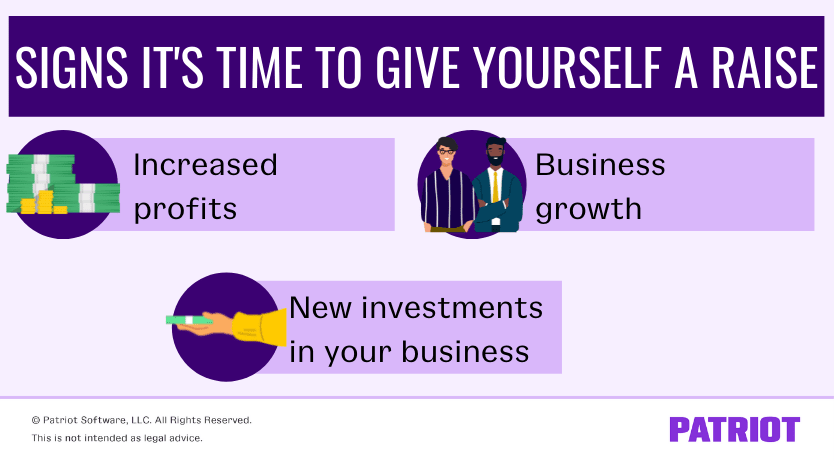As a business owner, you typically control your own salary. And if you see a rise in business income, you may think it’s time to give yourself a raise. But, how do you go about giving yourself a raise? What are some signs it’s time you increase your income? Keep reading for answers.
How to know it’s time to give yourself a raise
When you started your business, you may have been thinking more about the challenges, risks, and oh-so-sweet rewards of business ownership. Obviously, your salary is important, but it may not have been at the top of your list. What may have been more important than the salary itself was the ability to determine how much you get paid—not someone else deciding for you.
Before we can talk about when it’s time to know you should give yourself a raise, let’s take a detour to discuss how you pay yourself.
Salary vs. owner’s draws
There are four common ways business owners pay themselves:
- Owner’s draws: When a business owner uses the owner’s equity account to provide their compensation. Also called a draw, the compensation can be either funds the owner contributed to the business or profits.
- Salary: A fixed payment amount per year typically divided by the number of pay periods in a year (e.g., 26 pays if paying biweekly). Business owners may choose to pay themselves annually, if state law allows.
- Distributions: A company’s payment of cash, stock, or physical product to its shareholders. Business owners may be shareholders who can receive allocations of capital and/or income throughout the year.
- Dividends: Rewards paid to shareholders who invested in the company. Typically, rewards come from the company’s net profits.
Depending on your business structure, you may choose to pay yourself any of the above four ways. However, corporations typically cannot pay themselves using owner’s draws. Instead, distributions are common for corporation owners. Keep your business structure in mind when choosing how you pay yourself.
Signs you should give a raise to yourself
When you started your business, you probably set a determined amount you would pay yourself for the year, knowing that the amount could change. And if you’re considering a raise, your circumstances probably changed for the better.
So, how do you know your circumstances changed enough to justify a pay increase for yourself? There are a few ways to know it’s time for a raise, including:
- Increased profits
- Business growth
- New investments in your business

1. Increased profits
Many startups don’t include a salary for owners. If the startup does include a salary for a business owner, the salary is typically very small. After all, most business owners turn their profits back into the business to encourage growth.
But when you review your books and compare them to prior years, you may see increasing profits. Increased profits mean you have more cash coming in that you can use to invest in your company and bump up your pay.
According to Kristen Bolig, Founder of SecurityNerd, considering your numbers is key to knowing when to give yourself a raise:
It is important when considering giving yourself a raise to always look at your business’ financial numbers. As a business owner, you can’t just give yourself a raise whenever you feel like it. Give yourself a raise when your company hits a target or financial goal. This is a great way to stay motivated as a business owner and to hold yourself and the entire company accountable for goal completion.”
So, how much should that increase be? Well, that depends on you and your business. Consider speaking with your accountant to determine how much you can afford to increase your salary based on your financial reports. In many cases, small business owners choose to increase their salary based on a percentage of their profit increase.
For example, your business saw an increase in profits over the past year totalling $20,000. Of the $20,000 increase in profits, you decide to increase your own salary by 10% of the profits, or $2,000 ($20,000 X 10%). With the remaining $18,000 ($20,000 – $2,000), you can pay down business debts faster, reinvest in your company, or pay out funds to shareholders.
2. Business growth
Your business’s growth typically goes hand-in-hand with increased profits. But, business growth can be about more than profits. Signs of business growth include:
- New partnerships
- More employees
- Increasing customer base
If you started your business without paying yourself a salary, business growth may demand that you start. And, it may indicate that you should increase your salary if you already pay yourself.
Paying yourself shows investors and employees that you are serious about the success of your business. A pay increase can show those parties that you are serious about growing your business even more. After all, when you depend on your business to earn a personal income, it shows that you have just as much stake in the company’s success as everyone else.
So, if you see your business growing, consider upping your salary, too.
3. New investments in your business
You’ve likely been turning around a lot of (maybe even most of!) your profits to reinvest in your company. If your profits increase and your business grows but you haven’t yet given yourself a raise, a new investor may be what prompts you to do so.
Investors bring more capital to your business so you can grow faster. Generally, investors do so for a percentage of ownership in your business. New investors want to know that you are just as serious about your success as they are. So, you may want to give yourself a raise when you get a new investor if more profits or growth have not resulted in a pay increase.
| Need to know how to check the financial status of your business before you give yourself a raise? Check out our FREE guide, “How to Use Financial Statements to Assess Your Small Business Health.” |
How to give yourself a raise
Now that you know when the timing is right for a pay increase, how do you actually give yourself a raise? Well, the answer is a bit complicated.
When it comes to employees, many employers calculate the amount of a salary raise based on percentages. For example, you may increase your employee’s salary by 1% each year. Or, employers increase hourly employees’ wages by a set amount each year (e.g., $0.25 per hour).
But, is that how you should increase your own salary as the owner? Probably not. Instead, take a look at your increase in profits or investments. Use a percentage of that increase to determine just how much you should pay yourself. Unlike how you’d calculate a pay raise for employees, do not use your current salary to calculate your own pay increase.
Like with salaried employees, however, add the amount to your yearly compensation and divide it by the number of your pay periods.
For example, you give yourself a pay raise of $2,000 per year, based on your net profits. You pay yourself monthly. Your monthly salary increases by $166.67 ($2,000 / 12).
If you are unsure of how much your raise should be, consult your accountant.
This is not intended as legal advice; for more information, please click here.


